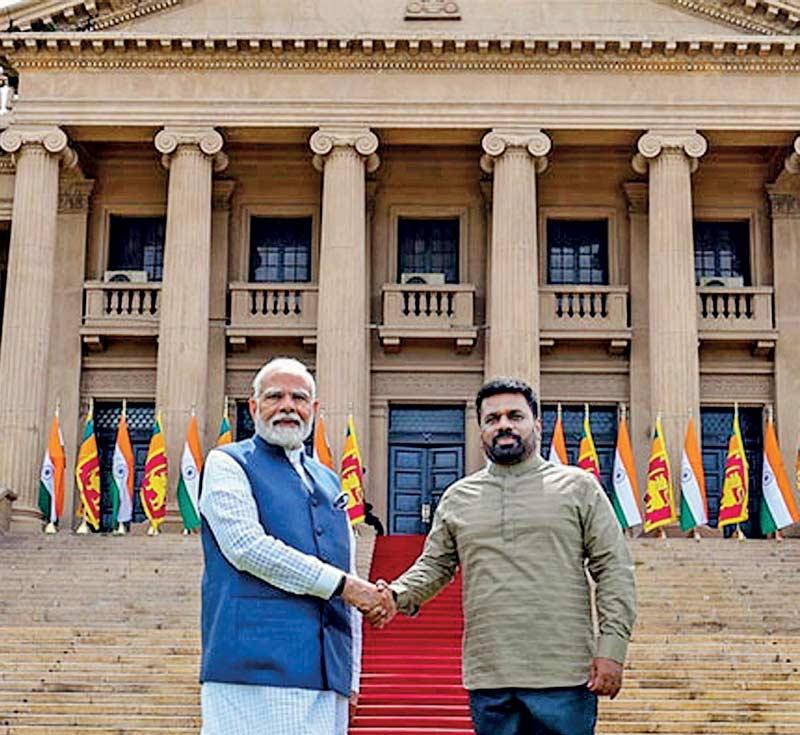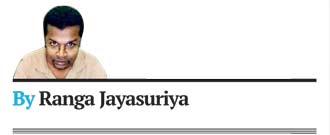
The handshake that builds bridges: PM Modi’s visit shows how far Sri Lanka has moved from its past
 India is Sri Lanka’s window for long-term prosperity and resilience that Sri Lankan policymakers fail to understand
India is Sri Lanka’s window for long-term prosperity and resilience that Sri Lankan policymakers fail to understand
 Key agreements signed include defence cooperation agreements, the Sampur solar power project, the upgrading of the Maho-Anuradhapura Railway, Energy connectivity and a tri-party agreement with the UAE
Key agreements signed include defence cooperation agreements, the Sampur solar power project, the upgrading of the Maho-Anuradhapura Railway, Energy connectivity and a tri-party agreement with the UAE
 An smoother relationship between India and Sri Lanka is expected under the current NPP Government
An smoother relationship between India and Sri Lanka is expected under the current NPP Government
 Indian Prime Minister Narendra Modi concluded a three-day visit to Sri Lanka last week, his fourth visit to the country and the first since the election of President Anura Kumara Dissanayake and the JVP-led NPP government.
Indian Prime Minister Narendra Modi concluded a three-day visit to Sri Lanka last week, his fourth visit to the country and the first since the election of President Anura Kumara Dissanayake and the JVP-led NPP government.
In some ways, the irony was rich for the JVP, whose megalomaniac leader, Rohana Wijeweera, conducted must-attend classes for the party cadres about the danger of ‘Indian Expansionism’. Those youngsters then, who survived the state counter-terror unleashed against their equally nihilistic terror campaign in 88-89, are now the much venerated old guard of the party.
PM Modi’s visit illustrates how far Sri Lanka—in all its bits and pieces—has moved from its past. It is also a case in point of the JVP’s transformation—mainstream politics is a great driver of socialisation.
In Sri Lanka, PM Modi signed a host of agreements, including the first-ever defence cooperation agreement between the two countries—the MoU aimed to formalise joint military exercises, information exchange, technological transfer, training programmes, and high-level exchanges.
The defence cooperation agreement is somewhat symbolic and institutionalises the cooperation between the two militaries in areas where they already cooperate. However, it could serve as a first step in a broader framework of future defence cooperation. The agreement essentially grants India a stake in Sri Lanka’s security, which could alleviate, at least in part, the perennial Indian anxieties over expanding Chinese influence in the island nation.
Among other agreements, PM Modi and President Dissanayake participated virtually in the groundbreaking ceremony for the Sampur solar power project, a joint venture between two countries, which was first mooted in 2003 as a 50 Mw coal power plant but was held in abeyance for the next two decades due to politicised protests and generalised lethargy of the government agencies. The twisted irony is that the most vocal protestors of the project then are now the Ministers of the incumbent government.
Modi also declared open a newly upgraded section of the Maho-Anuradhapura railway built on an Indian grant, signed an agreement on energy connectivity between the two countries, and a tri-party agreement—also involving UAE—to develop Trincomalee as a multi-product energy hub.
So far, so good
However, Sri Lanka has regularly failed to convert these ’MoUs’ into practical realities on the ground. That ingrained failure of successive Sri Lankan governments—may be due to vested political interests, protectionism, lack of imagination and gold star incompetence- has accounted for a long line of lost opportunities. Probably the lone silver line is, as I suggested last week, that some of the greatest obstructionists of Indo-Sri Lanka cooperation, such as the Rajapaksa’s pseudo-nationalist charade, have been reduced to political insignificance, and others, such as equally opportunistic JVP, have suddenly been thrust upon the political power of the state.
By simply being the government, the JVP has now removed the biggest obstruction to the long-term national interest of the country, i.e. the JVP itself. Strange as it might sound, one could expect a smoother ride for Indo-Sri Lanka relations under the current political dispensation in Colombo.
However, India is a much bigger economic opportunity than most Sri Lankan policymakers have grappled with. Be it due to a simple lack of imagination and initiative or pitiful prejudices and xenophobia, they simply fail to come to terms with the enormous window of opportunity India offers to Sri Lanka. Think Hong Kong to China—or, if it’s too glamorous, Vietnam’s recent rise in riding on China-centric supply chains.
To be fair, India may not be the quintessential free-trade-loving nation—its tariff and non-tariff barriers are extensive and designed to foster a highly protected market. That may also explain India’s failure, as the lead nation, to lead the regional economic integration in South Asia. The inter-regional trade of SAARC countries amounts to a paltry 5% of their exports and imports.
However, a smaller economy at the shooting distance of a US$ 4 trillion regional economic giant should be proactive in pushing for greater economic integration between the two countries- remove trade and non-trade barriers that discourage Investors and parcel out land on long-term leases for industrial parks run by globally successful Indian manufacturing giants and service providers.
India exported US$ 193 billion worth of IT-BPO services in 2023. Instead of seeking a greater integration, Sri Lankan industry experts are building fences around our IT industry with an annual revenue of barely US$ 1.5 billion.
The lack of initiative on the Sri Lankan side was displayed in a related event: Just as Modi visited, the United States slapped a 44% tariff on Sri Lanka and a 26% tariff on India. Industrious regional states, such as Malaysia, the current chair of ASEAN, which was also slapped with a 24% Trump tariff, had sought a collective South East Asian missive to negotiate a tariff deal with Washington.
Elsewhere, China, South Korea and Japan announced plans to expedite the talks for a free trade agreement—and over 50 nations have approached the Trump administration to renegotiate tariffs.
India, given its strategic importance as a counterbalance to China and Modi’s rapport with Trump, who likes authoritarian leaders, is well positioned to secure a deal with Washington. Sri Lanka, given its relative insignificance in the Trumpian world, where might is right, should have called for a joint approach with India to negotiate a deal, while it reaches out to Trump’s trade negotiators. But that simple ingenuity is too much to ask from Sri Lankan political leadership.
Also, Trumpian disorder is a rude awakening call for the economic straightjacket of Sri Lanka’s narrow and low-end export basket and its limited export destinations. An enhanced economic cooperation with India and an interlocking Sri Lankan economy with its neighbourhood giant provide the best guarantee for Sri Lanka’s prosperity and economic resilience.
But, you need a deep conviction in things for you to pursue them with a sense of urgency. But, most Sri Lankan leaders and their policymakers are captives of an ideological dogma of a foregone era.
So, Modi came, and Modi went. One doubts whether Sri Lankan leaders have a real appreciation of the enormous opportunity that they sit on.
